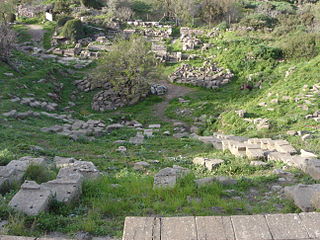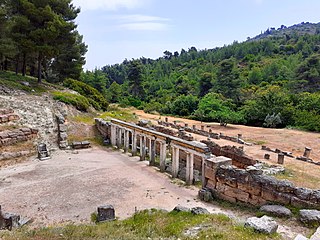
Cnidus was represented at the Sanctuary of Apollo in Delphi by the Treasury of the Cnidians of the late Archaic period and by a late Classical period building, called "Lesche", a kind of club for social gatherings.

Cnidus was represented at the Sanctuary of Apollo in Delphi by the Treasury of the Cnidians of the late Archaic period and by a late Classical period building, called "Lesche", a kind of club for social gatherings.
The remains of the Treasury of the Cnidians are situated just next to the Sacred Way close to the Siphnian Treasury to which they bear resemblance, to the exception of the smaller size.
It was a marble building, erected before Cnidus was conquered by the Persians in 544 B.C. Its features remind of the mid-sixth century B.C. The treasury was built in the Ionian order, prostyle, but there is not much information on the exact plan of its elevation and the roof. It is possible that there were korae (Caryatids) on the façade instead of plain columns. At the time of the Great Excavation it was thought that the friezes and sculpted decoration of the Siphnian Treasury actually originated from the Treasury of the Cnidians, a misinterpretation which led archaeologists to overestimate its artistic and aesthetic value. Pausanias [1] described the monument but was puzzled by its architrave inscription: what he failed to notice was that it was written "boustrophedon", i.e. from left to right and from right to left. The inscription bears a dedication of the building to the Pythian Apollo. Apart from the main inscription, its walls and antae bear about sixty more inscriptions, [2] mostly honorary decrees and manumission acts, as well as two decrees of a fiscal character, quite enlightening on the finances of the time.

Delphi, in legend previously called Pytho (Πυθώ), was an ancient sacred precinct and the seat of Pythia, the major oracle who was consulted about important decisions throughout the ancient classical world. The ancient Greeks considered the centre of the world to be in Delphi, marked by the stone monument known as the omphalos (navel).

In ancient Greek religion and mythology, Hestia is the virgin goddess of the hearth, the right ordering of domesticity, the family, the home, and the state. In myth, she is the firstborn child of the Titans Cronus and Rhea, and one of the Twelve Olympians.

In Greek and Roman mythology, the Giants, also called Gigantes, were a race of great strength and aggression, though not necessarily of great size. They were known for the Gigantomachy, their battle with the Olympian gods. According to Hesiod, the Giants were the offspring of Gaia (Earth), born from the blood that fell when Uranus (Sky) was castrated by his Titan son Cronus.

Praxiteles of Athens, the son of Cephisodotus the Elder, was the most renowned of the Attica sculptors of the 4th century BC. He was the first to sculpt the nude female form in a life-size statue. While no indubitably attributable sculpture by Praxiteles is extant, numerous copies of his works have survived; several authors, including Pliny the Elder, wrote of his works; and coins engraved with silhouettes of his various famous statuary types from the period still exist.

Erythrae or Erythrai later Litri, was one of the twelve Ionian cities of Asia Minor, situated 22 km north-east of the port of Cyssus, on a small peninsula stretching into the Bay of Erythrae, at an equal distance from the mountains Mimas and Corycus, and directly opposite the island of Chios. It is recorded that excellent wine was produced in the peninsula. Erythrae was notable for being the seat of the Erythraean Sibyl. The ruins of the city are found north of the town Ildırı in the Çeşme district of Izmir Province, Turkey.
The year 530 BC was a year of the pre-Julian Roman calendar. In the Roman Empire, it was known as year 224 Ab urbe condita. The denomination 530 BC for this year has been used since the early medieval period, when the Anno Domini calendar era became the prevalent method in Europe for naming years.

The Siphnian Treasury was a building at the Ancient Greek cult centre of Delphi, erected to host the offerings of the polis, or city-state, of Siphnos. It was one of a number of treasuries lining the "Sacred Way", the processional route through the Sanctuary of Apollo, erected to win the favor of the gods and increase the prestige of the donor polis. It was one of the earlier surviving buildings of this type, and its date remains a matter for debate, with the most plausible date being around 525 BC. Until recently it was often confused or conflated with the neighbouring Cnidian Treasury, a similar but less elaborate building, as the remains of the two had become mixed together and earlier theoretical reconstructions used parts of both.

Lycosura was a city in the ancient Parrhasia region of south Arcadia said by Pausanias to be the oldest city in the world, although there is no evidence for its existence before the fourth century BCE. Its current significance is chiefly associated with the sanctuary of the goddess Despoina, which contained a colossal sculptural group that Pausanias wrote was made by Damophon of Messene. This group comprises acrolithic-technique statues of Despoina and Demeter seated on a throne, with statues of Artemis and the Titan Anytos standing on either side of them – all in Pentelic marble. The dates of both the temple and the sculptural group have occasioned some dispute. Remains of a stoa, altars, and other structures have been found at the site as well. The Sanctuary of Despoina at Lycosoura is located 9 km WSW of Megalopolis, 6.9 km SSE of Mount Lykaion, and 160 km SW of Athens. There is a small museum at the archaeological site housing small finds as well as part of the cult group, while the remains of the cult statues of Despoina and Demeter are displayed at the National Archaeological Museum of Athens.

The Venus of Arles is a 1.94-metre-high (6.4 ft) sculpture of Venus at the Musée du Louvre. It is in Hymettus marble and dates to the end of the 1st century BC.

The Amphiareion of Oropos, situated in the hills 6 km southeast of the fortified port of Oropos, was a sanctuary dedicated in the late 5th century BCE to the hero Amphiaraos, where pilgrims went to seek oracular responses and healing. It became particularly successful during the 4th century BCE, to judge from the intensive building at the site. The hero Amphiaraos was a descendant of the seer Melampos and initially refused to participate in the attack on Thebes because he could foresee that it would be a disaster. In some versions of the myth, the earth opens and swallows the chariot of Amphiaraos, transforming him into a chthonic hero. Today the site is found east of the modern town Markopoulo Oropou in the Oropos municipality of Attica, Greece

The Serpent Column, also known as the Serpentine Column, Plataean Tripod or Delphi Tripod, is an ancient bronze column at the Hippodrome of Constantinople in what is now Istanbul, Turkey. It is part of an ancient Greek sacrificial tripod, originally in Delphi and relocated to Constantinople by Constantine the Great in 324. It was built to commemorate the Greeks who fought and defeated the Persian Empire at the Battle of Plataea. The serpent heads of the 8-metre (26 ft) high column remained intact until the end of the 17th century.

Delphi Archaeological museum is one of the principal museums of Greece and one of the most visited. It is operated by the Greek Ministry of Culture. Founded in 1903, it has been rearranged several times and houses the discoveries made at the Panhellenic sanctuary of Delphi, which date from the Late Helladic (Mycenean) period to the early Byzantine era.
Lesche is an Ionic Greek word, signifying council or conversation, and a place for council or conversation. There is frequent mention of places of public resort, in the Greek cities, by the name of leschai, some set apart for the purpose, and others so called because they were so used by loungers; to the latter class belong the agora and its porticoes, the gymnasia, and the shops of various tradesmen, especially those of the smiths, which were frequented in winter on account of their warmth, and in which, for the same reason, the poor sought shelter for the night.

The Temple of Apollo Zoster is an ancient Greek temple, the remains of which are located at Vouliagmeni in Athens, Greece.

The Athenian Treasury at Delphi was constructed by the Athenians to house dedications and votive offerings made by their city and citizens to the sanctuary of Apollo. The entire treasury including its sculptural decoration is built of Parian marble. The date of construction is disputed, and scholarly opinions range from 510 to 480 BCE. It is located directly below the Temple of Apollo along the Sacred Way for all visitors to view the Athenian treasury on the way up to the sanctuary.

Ptoion is a mountain chain in northeastern Boiotia. It stretches from Akraiphia by the former Lake Copais in the west to the Gulf of Euboea in the east, reaching up to 725 m in the west and 781 m (Petalás) in the east. The massif is particularly famed for the oracle of Apollo, which was located in the sanctuary of Apollo Ptoios at the western end of the range and was among the most important Greek oracles up to the time of the Persian Wars.

The tenth book of the work Description of Greece by the traveler Pausanias is dedicated to Phocis; its larger part constitutes a description of the sanctuaries and buildings of Delphi. His work constituted a precious aid to travelers and archaeologists who attempted to identify the monuments revealed by the excavations, although in some cases their identifications were not enough.
The Megarian Treasury was a building situated within the sanctuary of Apollo in Delphi, to the north of the Siphnian Treasury along the Sacred Way. On its façade have been inscribed 26 inscriptions referring to the citizens of Megara, a fact which led to the secure identification of the monument.
The Treasury of the Boeotians was dedicated in the late Archaic period within the sanctuary of Apollo at Delphi. It is identified due to some epigraphic material.
The Cave Sanctuaries of the Acropolis of Athens are the natural fissures in the rock of the Acropolis hill that were used as sites of worship for deities of the Panhellenic pantheon in antiquity. Traditionally a sharp distinction has been drawn between the state religion practised on the summit of the Acropolis and the cult practice of the shrines on the lower slopes. Recently, however, interest has burgeoned in the individual religious experience or personal piety in Greek society of which these cult sites may be the expression. The proceeding description follows the order of the shrines from the Klepsydra at the northwest face of the Acropolis clockwise via the Peripatos round to the foot of the Nike bastion.